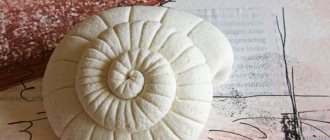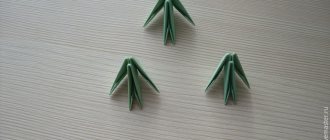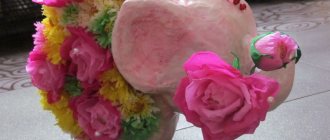Photo: culture.ru Origami flowers are not only pleasant leisure time and relaxation. You can use them to create interesting decor, glue them into an effective panel, or collect a whole bouquet as a gift. Today we will teach you how to make roses, irises and lotuses - and this is just the beginning! We have collected 8 step-by-step diagrams that you can make with your own hands and from scrap materials!
History of origami
As you know, Japan is considered to be the birthplace of this art. It was here that art reached a significant level of development. But the Chinese, Germans and Spaniards also sometimes used origami. The traditions of paper folding in these countries have not received such development. And therefore, when mentioning the homeland of this art, everyone remembers Japan.
It is noteworthy that origami became a significant part of Japanese culture already in the Heian period. Samurai used origami as a meaningful gift to their comrades, and beautifully folded sheets of paper were actively used during wedding celebrations. And already in 1960, origami was elevated to the rank of international art.
"Lotus"
Step 1. We need a square blank. You can use large squares, since the product has many folds.
Step 2. Next, bend the square diagonally and place all the corners in the middle. It should turn out to be a rhombus.
Step 3. Turn the diamond into a square post, and fold the corners again towards the middle to create a diamond. Do the same thing again.
Step 4. Fold the small corners up and turn the product over.
Step 5. Open each pocket upward and straighten the petals.
The lotus is ready!
Yoshizawa Akira: the story of the famous master
People who are seriously interested in origami simply cannot help but know this name. This man is an outstanding master who made a truly great and significant contribution to the development of the art of folding paper figures.
Mr. Yoshizawa is rightly considered the pioneer of most of the methods used for folding figurines. Because it was he who had to prove from his own experience that all of them could be used in the future. The master was able to achieve the greatest success in a technique called wet folding.
Origami anemone
An excellent option for beginners in this business would be creating an anemone. To make it you will need seven sheets of square paper for the petals.
Next, bend each square in half, folding the resulting rectangle up diagonally. The next step is to bend the workpiece along the lines marked with a dotted line in the diagram and get one finished petal.
Repeating the procedure in this way, several petals are made, which are then glued onto a small triangle.
Types and techniques of origami
The process of folding any model must first be recorded. Of course, we are not talking about writing in words. For designation, certain signs are used that are universal. It is with their help that it is possible to record the folding process in the form of drawings, which should then be used for work.
This system of signs was invented by Mr. Yoshizawa. And today, types and patterns for folding flowers are actively used. The following paper folding techniques are widely known:
- modular origami;
- simple origami;
- pattern folding;
- wet folding.
It is noteworthy that only a few craftsmen know about the existence of the last mentioned method of folding paper. Because most people who are interested in this art prefer to use simple or modular origami.
Origin of origami
Referring to reliable data, this fascinating activity most of the time developed in Japan. This technology was used to fold a lot of decorations for weddings, exchange symbols for good luck, and so on.
In the nineteenth century, this type of art was introduced into preschools throughout Europe under the pretext of the rapid development of fine motor skills in children.
Origami paper: the importance of choice
Before you start folding the figures, you should choose the paper with which the master will work. After all, the question arises: what can you use to make an origami flower? This is a very important point.
Because the choice of paper directly affects the final appearance of the model. The modeling process itself can also be simplified or complicated by choosing one or another paper.
For beginners, it is enough to remember only that for folding they will use paper that is usually used for a printer. Paper over 100 g/m2 is necessary for those who plan to work using the wet folding technique.
To make your work as easy as possible, you can purchase kami paper. It is sold already cut into squares. This paper is lighter than printer paper, so it can be used to model many figures.
Decorative flowers
Stylized floral patterns are more suitable for postcards. They are two-dimensional and look good on a plane.
Sunflower
Hydrangea
Poinsettia
Having learned from simple models, you can try to make a spectacular orchid with your own hands. Origami flower according to the scheme of Sergei Suvorov in the video tutorial:
Additional materials for work
Typically, folding figures using the origami technique does not require additional materials. But flower figures are an exception. Because in this case there is a need to create a figurine that will be as similar as possible to the original. Therefore, you will have to stock up on everything you need in advance:
- gerbera wire with a cross-section of at least 0.5 mm;
- tape;
- scissors;
- wire cutters;
- pencil or toothpick.
Please note that it is important to choose the right wire so that it is comfortable to work with. It shouldn't be too thick.
Paper flowers using quilling technique
Paper flowers made in the quilling style are extremely popular and look impressive and beautiful, especially if made by yourself. They can be used to decorate holiday packaging, boxes, photo frames, and greeting cards. The technique is simple, but it requires patience and time.
This technique can also be called “paper twisting,” since it involves twisting oblong paper strips of different structures. Stripes made from pearlescent, shiny or matte raw materials will look impressive.
The simplest manufacturing technology is as follows:
- Having cut out the strips, you need to twist them in the form of spirals using an awl or a thin rod;
- give the resulting curls the desired shape by pressing or pressing;
- Glue the resulting elements together and secure them to the base.
There are many ways to create compositions using the quilling method. The main thing is to have a diagram that has the contours of the image and the details that fill it. It is better for beginners to gain experience by performing light patterns.
Chamomile: the secret of a beautiful flower
Step-by-step instructions on how to make a flower with your own hands are quite simple. But now there is one more small detail to know. To make a paper daisy really beautiful and look like a real flower, you need to provide it with a large number of petals.
It is necessary to fold the rhombus into a triangle so that the base of the figure is at the top, and then you need to bend its sides in the direction from the top - this will be the petal. The more such petals, the better. Then you can use glue to fix the figure on a solid base so that it looks three-dimensional.
Origami "Lotus"
Take a large square piece of paper - the bigger the better, because there are a lot of folds in this origami. Mark its diagonals and bend all four corners towards the center - you will get a rhombus. Turn the rhombus over into a square with the base straight down, and fold all the corners again, and then again.
Fold in the small corners along the edges and turn the workpiece over to the other side. Unfold each section upward, slightly short of the fold, and straighten the petals from it. To make your origami paper lotus voluminous, you can combine several of these blanks and glue a water lily base to it.
Photo: waroung-kreasi.blogspot.com
10 best plans for making a paper airplane
Paper tulips
- Mark a square piece of paper with folds and center lines to form a triangle.
- Bend the corners located at the base on both sides.
- Flip one of the segments from right to left.
- Fold the sides of the resulting diamond towards the middle, tucking them in first.
- Unfold the second layer of the diamond and do the same with this part of the figure.
- Form a bud and bend the petals to the sides.
Origami "Rose"
Not the simplest, but very effective scheme, for which you traditionally need a square sheet of paper. Fold it in half twice and unfold the top layer of the small square into an isosceles triangle. Then turn the parts over and do the same on the other side.
Fold the lower corners at the base of the “book” upward towards the top and straighten each of them into a small square. Fold back the top of the small squares, as in the diagram, to create an impromptu seamless house. Turn the workpiece over and repeat all manipulations on the other side.
Unfold the top of the piece according to the pattern to reveal the petals, turn the square over and fold it into quarters. Take the future flower by the middle and carefully scroll clockwise to form it. Use a toothpick to turn the sharp corners to make the rose round.
Photo: koffkindom.ru
Paper figurine "Iris"
A hexagon should be cut out of paper. Make diagonal markings on it, and then fold it into a quadrangular petal. Its corners must be bent inward.
Form petals by straightening each triangle. Turn it 90 degrees downward so that you can place the bud vertically, which must then be straightened.
Origami "Poppy"
A simple origami poppy made of paper is suitable for panels, appliques or decoration, or you can just put it on the table. Although it is assembled from several parts, it is very light and understandable even for children. You will need four red petal blanks and one green stem with a leaf.
For the flower stem, use folds to mark the diagonals of the square and the places where the sides fold towards the center. Fold a thin narrow rhombus along these lines, turning the side corners up. Fold the bottom sides over again and fold the piece in half with the narrow part facing up. Pull the stem a little to the side, straighten the leaves and give the part stability.
Mark the diagonals of the diamond, fold the side corners to the middle twice and immediately fold the top to get a petal shape. Turn the part over, mark a fold at the pointed end, bend the corner to it and fold it. Fold the lower right part inward and you will have a pocket into which you can then insert the next petal of the same type.
Photo: labirint.ru
Paper violet
- Cut out a pentagon from paper.
- Mark its center and diagonals.
- Collect a petal that is shaped like a diamond. Assemble it in such a way that there is one internal bend on the left side, and two on the other.
- Fold the right edge 1 cm across all layers.
- Do the same on the other side.
- Pinch the base of the flower with all the petals facing down.
- Roll the flower while holding the base to give it shape.
- Fold the outer and inner corners to give the petals a beautiful shape.
"Tulip"
Step 1. Place a square piece in front of you. Fold in half lengthwise and crosswise, then diagonally. Smooth out any creases.
Step 2. Unfold the workpiece and fold it into a triangle according to the diagram.
Step 3. Fold the top right and left corners alternately towards the center to create a diamond shape. Do the same on the other side.
Step 4. Move one fold from right to left and tuck the sides of the resulting diamond to the center, insert the edges one into the other. Do the same on the other side.
Step 5. Inflate the bud and bend the petals to the sides.
Next we will make the stem.
Step 1. To do this, take a green square blank and arrange it like a diamond.
Step 2: Fold the top edges toward the center and then the bottom edges toward the center. Fold the top edges up and fold the piece in half at the top.
Step 3. Fold it in half again along the leaf.
Step 4. All that remains is to open it.
Our parts are ready. Collect a flower by placing a bud on a leaf.
Lily: a simple diagram of a complex flower
To make the flower even more beautiful and without having to paint it, you can use kami paper painted using the ombre technique in the process. The technology itself is quite simple:
- form a multilayer diamond out of paper;
- expand the side corner;
- do this with all parties;
- turn the workpiece over with the flat side facing up;
- bend the top corner down;
- bend the long “legs” up;
- fold their sides and bend the upper part from below;
- straighten the bud.
To make it easier to straighten the bud, you can use a pencil or toothpick. Using these simple flower designs for beginners, you can even create a beautiful lily.
"Iris"
Step 1. Initially, you need to prepare a hexagon from thick paper.
Step 2. Next, mark the shape like a diamond. Following the diagram, fold the piece into a petal with four corners.
Step 3. Fold the corners inward.
Step 4. Next we model each petal separately. Following the diagram, straighten the triangles and turn the folds over.
Step 5. Bend each petal forward down at a right angle. Do the rest in the same way.
Your flower is ready!
Decorative paper bouquets
Having learned to arrange flowers using any of the proposed technologies, the master will be able to try his hand at making compositions from them. Such crafts can be used not only as souvenirs.
A paper bouquet can be presented as a gift for any occasion. But it is necessary to work out this composition and decorate it so that it looks more beautiful and resembles a real bouquet.
Paper napkin flowers
Graceful flowering plants can be made from ordinary napkins. Very simple production helps to attract children to this activity. Paper napkins, which have one or more layers, can turn into different types of flora. You just have to choose the right scheme and color scheme.
You can learn this technique using the example of a lush flower. It is better to use dense material, because it retains its shape well, and the folds on the folds are well defined. You will need 5 napkins for one product. To increase the splendor, you can use from 7 to 10 pieces, but it is advisable to make the blanks of different sizes. Craftsmen advise alternating material of different colors.
Manufacturing instructions:
- To form a flower from paper, you need to cut the edges of the raw material with your own hands into a semicircle or rounded triangle. Next, you need to give each napkin an accordion shape, fastening it in the middle with a strong thread. Then trim the ends a little, making them uneven, to give a ragged effect;
- collect each inflorescence into a single composition, putting them together and fixing them at the ends of the threads;
- for the density of the masterpiece, the base of the leaves should be glued or tied with braid;
- If desired, you can attach a ring made of the base material to the back of the product, which will serve to hold a table napkin or cutlery.
Panel of flowers
Another way to use paper crafts is as a decorative panel. But you should remember that it will require a large number of crafts. While composing a bouquet may require only a few flowers, a panel requires several dozen.
In addition, it is important to outline the location of all the figures in advance. Therefore, this option for using paper flowers is suitable for advanced craftsmen who have already learned how to make panels.
Miscellaneous beautiful
A few more useful MKs. All pictures are clickable
roses cornflowers kusudama lily camellia lily rose
Photo of origami flowers made of paper
What kind of paper can be used to make flowers?
Floral arrangements, both voluminous and the simplest, can be created from simple office sheets, not only pure white, but also colored.
Types of paper that can be used to make flowers:
- corrugated;
- kraft paper;
- packaging;
- newspaper, suitable for making bouquets in a printing house;
- sheet music that will be an excellent solution for decorating a music classroom;
- geographic Maps;
- cosmetics catalogues;
- used writing paper;
- magazines;
- tracing paper;
- graph paper;
- multi-colored foil;
- material painted with different banknotes;
- parchment;
- cigarette
Decorations made from colored paper baskets will look stylish in children's institutions.
How to make a primrose flower in modular origami:
1. From origami paper you need to fold the basic shape of a double square.
2. Place it at a closed angle towards you. Bend the side corners towards the center line.
3. Then open them and hide them inside.
4. You get a triangle like this on top if you do it on the left and right.
5. Turn it over and repeat steps 2-4 in the same way. It will look like this if you look from above.
6. Place the figure again, as at the beginning, at a blind angle towards you.
7. Bend the upper free corner towards you, down.
8. Straighten it back and wrap it inward - hide it.
9. Turn over like a page in a book and repeat steps 7 and 8.
10. Fold all the corners in the same way.
11. Now on each side we bend the upper corners towards the central fold.
12. Then we straighten them and fold them flat.
13. Repeat on each side, turning the page over.
14. It turns out like this.
15. The final stage in folding the primrose flower module: straighten the corners with your finger, giving the flower volume. First on one side.
16. It looks like this as a result.
17. Then from the opposite side.
18. And from the two remaining sides. It turns out a primrose flower using the modular origami technique.
19. Every flower needs greenery - sepals are most often used in modular flower origami. They are folded from green paper. Then the flower module is inserted into the sepal module.
20. You can attach a skewer to the back side.
21. By folding 3-5 of these flowers from origami modules, you can make a cute spring bouquet. And if you have the patience for a larger quantity, you can collect a Kusudama “Primrose” flower ball.
Callas with their flower shape are somewhat similar to a heart; by giving such flowers, you will delight your loved ones.
Now you will learn how to assemble these flowers from modules. This modular origami bouquet of calla lilies can also decorate your interior.
the modules from A4 sheet 1\64
Blooming balls for decoration
You can make not only a paper flower, but also a real flower ball with your own hands. They are good for decorating a room, both for a holiday and on a weekday.
The easiest way is to make a ball using regular napkins.
This craft is fun to make together with your child. To do this, you need to crumple the old newspaper into a tight ball and rewind it with woolen thread. This will be the foundation. Then fold the paper napkin into 4 layers and fasten the middle with a stapler. Using scissors, round off the ends of the square and press them to the center in layers. Glue the resulting roses to the previously prepared newspaper.
The resulting composition can be decorated with beads, colored paper leaves and placed in a vase or attached to the ceiling with a ribbon. Another type of balls can be made from corrugated paper. First, make a round base for the future composition. It is necessary to inflate a balloon of the required size and wrap it with thick thread, pre-impregnated with PVA.
After drying, pierce the ball with a needle and remove it from the thread frame. Then glue the resulting frame to a suitable stand (pot, flowerpot). If the product will be hung, attach a ribbon to the base, forming a loop from it. Cut the sheet of corrugated source material into pieces measuring 3-4 cm by 30-40 cm.
Stretch the resulting strips by hand from one edge, then roll them into a roll from the other and rewind them with thread. Glue the created roses to the prepared base with the knitted side. Fill the entire area of the frame with blanks.
There are a lot of ways to create paper flowers with your own hands. You just need to choose the option you like and, of course, try it. After all, a composition made with love by one’s own hand will never fade and will bring positivity and joy.
How to make a garland of paper flowers
Flowers for the garland can be made in small or large sizes. Small items are combined into garlands that decorate any part of the room.
To make a paper flower garland you should:
- Cut out a flower template from cardboard and use it to make an even number of paper elements. Choose the color scheme based on the theme of the celebration.
- Take the fishing line and straighten it. Next, glue the two parts together so that the connecting thread is located in the middle. We go to the end along the entire length of the base, after which we tie a ring at each end of the fishing line, with the help of which the garland will be attached to the holders.
- It is advisable to place the flowering elements with an interval of 3 cm from one another.
If desired, you should use stencils with complex patterns. The main thing is to carefully and evenly make paired parts.
Master class Craft product Origami Chinese modular Modular origami “Lotus” Paper Glue
I have seen a similar lotus on the Internet more than once, but MK and the diagram are nowhere to be found (at least I haven’t found one). Many people are looking for a diagram or a master class, I decided to help))) This is the lotus we will make today )) For him we need: white -271; pink - 1064; green - 780 Module size 1/32.
So, let's begin ))
Thus, we collect 2 rows of 8 pieces in each row. We close the chain.
Third row 16 pcs. We dress this way (shown in a different color in the photo).
Fourth row 16 modules. We dress as usual.
Carefully, holding the edges, turn the workpiece inside out.
Fifth row 32 pcs. Add in the same way as in photo number 5, only with the reverse side.
Sixth, seventh and eighth rows of 32 pcs. in every row. We dress as usual.
The ninth and tenth rows are 32 pcs. but we put it on with the long side out. The ninth row is white, the tenth is pink.
Now we collect the top six leaf (that’s what I call it). We collect 2 rows of 54 pieces. in each row. It is better to place it on glue.
Third row 1 white module, 8 pink, 1 white, 8 pink, etc.
Fourth row: 2 white, 7 pink, etc.
Fifth row: 2 white, 6 pink. We dress this way.
Sixth row: 2 white, 5 pink, etc.
Seventh row: 2 white, 4 pink.
There are 3 pink ones in the eighth row, 2 in the ninth row, and 1 in the tenth row.
The eleventh row is 2 white, the twelfth row is 1 white. Our six-leaf pattern is ready.
Now we make the bottom six-sheet. We collect 3 rows of 66 pieces.
Fourth row: 1 white, 10 pink, etc.
Fifth row 2 white, 9 pink, etc.
Sixth row: 2 white, 8 pink, etc.
Then, as in the lower six-leaf, we gradually make the petals narrower towards the top. The seventh row is 2 white and 7 pink, the eighth row is 2 white and 6 pink, etc.
We slightly raise the center of the upper six-leaf leaf and carefully insert the crown of our flower into the hole.
This is what the workpiece looks like from the reverse side.
It is advisable to glue the joint using a heat gun.
Glue the lower six-leafed leaf and bend it into the shape of a lotus.
And here are our leaves. We collect 6 rows of 39 pieces. in every row.
Seventh row. We put one module on one ray. Thus, there are 78 pieces in the row.
The next row, we put on 12 modules in the usual way, skip 2 rays, put on 12, skip 2, etc.
Next, we put 11 on top of these 12 modules.
Then 10,9,8,7, etc. Now the leaves are ready))
We connect all the details and voila))) Our lotus is ready)))
Here it is in red)))
THANK YOU SO MUCH to everyone who looked)) This is my first MK)) I hope I explained everything clearly))
Modular origami is more complex than simple origami for children and requires attention, perseverance, spatial thinking and patience. However, modular origami is not difficult to fold. The main thing is to be careful! Flowers in modular origami take pride of place. Along with thematic figures for the holidays (for example, an Easter egg on a stand using the modular origami technique), they are created from simple modules. It’s a little more difficult to make volumetric modules. For example, the primrose flower. It turns out beautiful and strict.
For work we will need the following materials:
- square of origami paper with a side of 10 cm.
Nuances and purpose of origami colors
Although the art of origami is characterized by such qualities as complexity and intricacy, flowers made in this way are considered one of the simplest crafts.
If you wish, you can put together either a modest bouquet of violets or a large floral panel. Over time, the products will begin to become more and more naturalistic.
Flowers made using this technique can play the role of interior decoration.
They can also be used to decorate gifts and use them in cards. They will always look fresh, giving pleasure to the eyes. There is no need to perform any labor-intensive actions to care for them.
Classic manufacturing technique
The art of creating paper flowers can be considered a separate direction of handicraft creativity - from the simple traditional technique of folding buds to complex patterns with numerous bends. Sometimes one type of plant has several variants of diagrams or instructions. Some of them are so unusual that their results can be confused with real flowers.
There are many ways and techniques on how to make an origami flower that is not inferior in beauty to its original.
For beginners, mastering the creation of a paper tulip will be a suitable option. Its bud is easy to make and understandable to anyone who is at least a little familiar with origami. In kindergarten or during labor lessons in the classroom, children will be able to repeat step by step the execution of such a flower model and give it to their mothers.
To work you will need square sheets of colored paper.
Modular flowers
Assembling decorative flowers from individual modules is a difficult task and requires a responsible approach.
Such decorative items are made by connecting typesetting elements, the number of which can exceed several hundred.
Let's look at how to create a simple module:
- Place a rectangular piece of paper in front of you. The short side should be vertical.
- Fold it in half along the horizontal axis.
- Fold the upper corners towards the central vertical line.
- Turn the workpiece over. Fold the bottom corners towards the base of the triangle.
- Fold the bottom of the workpiece - you should get a triangular workpiece.
- Fold it in half vertically. The module is ready!
And now it's time for creativity. There are no exact guidelines for making modular flowers. Ready-made crafts are available on the Internet.
As a result, using our own imagination and guided by the examples of experienced craftswomen, flower arrangements are freely assembled from modules, focusing on realism.
For example, to create a field daisy, the following colors are required: white, yellow and green. You should start assembling from the center of the bud. The work ends with the formation of leaves.
Stylish and incredibly beautiful paper flowers can serve as an excellent addition to the main gift, because they will never wither, and they do not need special care. Folding them is a good way to spend your free time.
You can also involve your child in making such figures, because origami stimulates the development of children’s imagination, improves fine motor skills, and develops perseverance, attentiveness and accuracy.
Chamomile
How to make chamomile:
- cut a circle from yellow cardboard for the core, the diameter of which is 11-12 cm;
- take a white piece of paper and cut it into long strips 2-3 cm wide. Without bending them, glue the edges of the strips together;
- Glue the purchased petals along the upper edge of the cardboard circle. If necessary, attach another yellow circle on top to mask the connection points;
- To form a stem, you need to insert a thin rod wrapped in green paper into the middle of the cardboard, to which you need to glue pre-prepared green leaves. For a more beautiful appearance, it is advisable to use double-sided raw materials.
If you make chamomile in the quilling style, you should:
- make paper strips 3 cm wide in white, yellow and green colors;
- wrap it around the awl, then remove it and loosen it slightly;
- to obtain a drop-shaped shape, you need to slightly pinch the petal on one side;
- secure the ends of the strips with glue. For splendor, you will need a lot of such droplets.
- We make the middle of the future flower from a yellow blank. On one side, cuts are made as thickly as possible on the fringe strips. Then we roll it up into a spiral. Attach the petals to the reverse side;
- Make a stem from corrugated material, winding it evenly around the rod. Attach a flower to one of the ends of the resulting blank.











